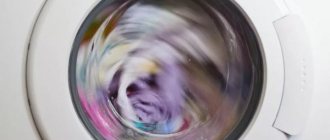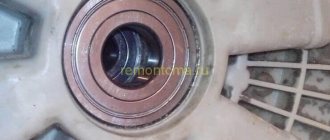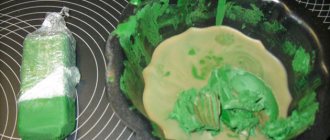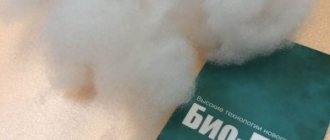During the operation of washing machines, many parts are exposed to water with detergents dissolved in it and contaminants from clothing. Over time, this leads to the formation of both limescale and elementary dirt (soap deposits, oil deposits, etc.), which subsequently leads to the appearance of fungus and a corresponding odor. This problem is especially relevant for washing machine drums. How to clean the drum in an LG washing machine will be described in detail in this material.
Cleaning function: operating features
The process of cleaning laundry is in many ways similar to regular washing. There are several stages in the process:
- Using the pre-wash mode.
- Switch to main mode. First, the wash is done at 60 degrees, at 150 rpm.
- The program ends when using a double rinse, together with a spin, accompanied by maximum speed.
Maintenance monthly cleaning should be enough to prevent serious gaps from forming. It is recommended to remove all debris from the drain tank before using the function.
The use of this mode does not eliminate various formations in the form of scale.
LG drum cleaning function: proper activation
In most models, the function is programmed so that only one button needs to be pressed. What actions need to be taken?
- It is necessary to remove all things and any foreign objects from the drum.
- Next, close the hatch.
- First, the start button is pressed. Next, hold and press the buttons on which the stars are displayed, and at least three seconds should pass. You need to wait until the text tei appears on the panel.
- The function starts when you press the Start button, as in other cases.
- The program usually completes in 1 hour 35 minutes. Afterwards, the drum needs to be dried completely, leaving the hatch open. This completes the cleaning of the drum in the LG washing machine.
It is not recommended to add detergents or cleaning agents during cleaning. Otherwise, a large amount of foam will form and the equipment may freeze.
Removing scale from heating elements
The formation of scale on the heating element is an inevitable process . The appearance of plaque is promoted by high temperature, the detergent itself and impurities that are in the water.
In addition to lime, threads and fibers from fabric can literally be welded onto the heating element. As a result, the heating element begins to become overgrown with a thick layer of scale and, as a result, breaks.
To keep the heating element clean, it is necessary to carry out regular cleaning. Both store-bought products and folk recipes are suitable for this purpose.
Soda and vinegar
This recipe has a peculiarity of application - the ingredients are not mixed immediately. Procedure:
- in a bowl, mix ½ pack of soda with water to form a thin paste;
- pour the resulting mixture into the powder receiver compartment;
- measure 1 cup of vinegar and pour it into the drum;
- close the hatch door;
- select the “cotton” mode, set the maximum temperature and long cycle;
- install additional rinse;
- start the washing machine;
- ventilate the drum.
If the washing machine has not been cleaned for a long time, after the cycle has completed, you can run the rinse only again to thoroughly rinse the tank and remove any remaining dirt.
Lemon acid
To clean your LG machine from scale and deposits, you can use citric acid. Rules of application:
- Make sure there is no laundry in the washing machine.
- Close the hatch door.
- Pour 150 grams of citric acid into the vice compartment of the powder receiver.
- Select the “Cotton” washing program and set the maximum temperature.
- Start the program.
- After finishing washing, ventilate the drum.
The cleaning method using citric acid will be useful, especially in cases where the tap water is very hard. In this case, it is recommended to add citric acid even when selecting the self-cleaning function.
Industrial products
LG special cleaning products are ready-to-use preparations that can be purchased in hardware departments of stores or ordered in an online store. Such products are used strictly according to the instructions given on the packaging. Their main purpose is to combat scale and prevent the formation of mold.
Well-proven means of complex influence include the following products:
- Beckmann (Germany);
- Magic Power (Germany);
- Tiret (Poland);
- Sano Antikalk Scale Remover (Israel);
- Topperr 3004, 3233 (Germany).
Mechanical cleaning
If there is a suspicion that the heating element of the LG washing machine is in poor condition and is thoroughly overgrown with scale, dry cleaning cannot be carried out. This warning is associated with the danger that pieces of sediment will literally fall off the heating element and get into the drainage units, and also begin to contaminate the laundry being washed.
The way out of this situation is to remove the heating element and clean it separately. To do this, you will have to partially disassemble the washing machine and gain access to the part from the rear wall.
The removed heating element can be tested with a multimeter. If performance is unsatisfactory, it may even be necessary to replace the part rather than clean it.
Procedure:
Rinse the heating element in hot water, trying to remove large deposits with a sponge and hands. Abrasive brushes, sandpaper and other similar tools should not be used to avoid damaging the heating element.- After large pieces of scale have been removed, it is necessary to treat the part chemically.
In a 1.5 liter plastic bottle, the top part is cut off so that the spiral part of the heating element can be lowered inside. - Pour 4 tablespoons of citric acid into the bottle and add hot water.
- Stir the solution.
- Place the heating element into the solution.
- Leave to act for a day.
- Clean with a sponge.
- Rinse.
- Place it back in the washing machine.
After the heating element has been removed to put it in order, it is advisable to inspect the lower part of the tank through the groove into which the removed part was placed. If there is debris there, it should be removed.
Cleaning: why is the function needed?
Along with the laundry that is loaded into the machine, the following items may get inside washing machines:
- Coins.
- Pins with paper clips.
- Threads.
- Lint particles.
- Fabric fibers.
- Sand particles.
It is necessary to carefully check the things loaded inside to avoid serious damage in the future. Lumps of dirt must be removed. If you are washing a delicate item, you cannot do without using a special bag.
Using dirty water often leads to problems and blockages. The parts inside the machine collect scale due to the salt contained in the metals. An excellent solution for many problems is special compositions and filter substances for liquids. Calgon and Alfagon are one of the acceptable options.
The main reasons for dirt getting into the car
Dirt and foreign objects get not only into the drum, but also into various parts and elements of the washing machine.
Trivial causes of blockages
The reasons for contamination of a Samsung device can be either dirty laundry or poor quality water. For example, dirty laundry can get into the machine:
- Sand.
- Solid dirt particles.
- Threads.
- Pile.
- Foreign objects from pockets (changes, pins, paper clips, etc.).
Important! Along with dirt, grease can settle on the walls of the drum, forming fertile ground for the growth of mold fungi and various bacteria.
Simple preventive measures
To avoid contamination of the machine, the following rules must be observed:
- Be sure to check your clothing pockets before washing and remove all foreign objects from them.
- Before washing, shake off dirt and debris from items.
- Wash delicate and damaged old items in to protect machine parts from lint and threads.
Technical reasons for tank contamination
However, even if you follow all the washing rules, it is very difficult to protect the device from scale, which settles not only on the inner walls of the drum, but also on the heating element.
Important! Limescale can damage all moving parts of the washing machine.
The main cause of scale deposits is water containing metal salts. This type of water is also called “hard”. Special compounds that should be added before washing will help soften low-quality water.
Important! The most common means are “Alfagon”.
However, many experts believe that these drugs only harm machine parts, since the chemical compounds they contain destroy the elements of the device over time.
Important! To ensure that household appliances serve for many years, are not covered with scale, and that cleaning the drum of the LG washing machine is required as little as possible, experts recommend using special ones that improve the composition of the inlet water.
What substances can be used for cleaning?
You can use popular recommendations to get rid of dirt if there is no cleaning function. Special chemicals also help, but they must be selected with extreme caution.
Here are just a few acceptable “helpers” in solving the problem:
- Vinegar.
- Soda.
- Lemon acid.
Each option has negative and positive sides.
Application of citric acid
This is the most common product used to remove scale, mold, and traces of grease. It is enough to take 200 grams of dry acid powder to perform one cleaning procedure. When using such tools, the advantages will be as follows:
- Possibility to use automatic drum cleaning mode.
- Safety for constituent components.
- Availability.
- Low cost.
The disadvantage is that citric acid will not be effective if the contamination case is particularly severe. It will be difficult to clean the inside of the device if the drum has not been cleaned for many years. It will be necessary to apply citric acid several times, or choose another method that is more effective.
Using baking soda
Baking soda is suitable for getting rid of dirt accumulated on the walls. But the tank and heating elements will require other methods.
The procedure involves using only 150 grams of the substance.
The method has the following advantages:
- Safety of machine parts.
- Efficient in drum cleaning.
- Availability.
- Low cost.
The disadvantages are that the cleaning process is done manually. In addition, you need to wait a certain time for the soda to interact with water.
Using baking soda requires following the following sequence:
- The walls of the machine are slightly moistened. But you can’t moisten it with plenty of water.
- Pour a little product onto a rag.
- We wait half an hour until the active substances begin to interact with each other.
- Dirt is completely removed with a cloth.
What about vinegar?
This is a concentrated substance that can be used to clean various parts of washing machines. 50 milliliters of the product are diluted with the addition of 150 ml of water. Vinegar essence cannot be used without such dilution.
The cleansing process does not require additional actions from the user. The product has a low price. The procedure is also effective. But vinegar is quite difficult to wash out of the inside of the drum. Rubber parts of cars may be damaged by the substance.
Cleaning individual elements of the washing machine
The answer to the question regarding how to clean an automatic washing machine will be incomplete without talking about ways to get rid of dirt and odors by cleaning individual parts and compartments. Now you'll learn about treating areas that are harder to reach, like the tray where you put your laundry detergent.
No. 1. How to remove and clean the tray
- Determine the type of its fastening. Most often it is attached to the side latches. Press them and pull the tray towards you, at the same time lifting it slightly. There are models with a button on the side. If you have one, then hold the button and release the fastenings.
- After removing the tray, wash it well under the tap.
- Use a brush to remove any remaining detergent from all accessible grooves. When the scale is difficult to remove and mold is visible, you will need “lemon”, “Belizna” or soda.
- Check to see if there are any traces of detergents left at the attachment point.
A common place for debris to accumulate and mold to grow is the rubber gasket used to seal the hatch.
No. 2. How to wash a rubber seal
Often fungus forms on the seal and under it. How to clean an automatic washing machine when you can’t get rid of the dirt inside the machine under the rubber band at home even with strong drugs? There is an exit!
- Carry out the manipulations immediately after the next wash or run the program without items inside. Do not allow the sealant to dry out.
- Use ear cleaning sticks or a rag - wrap it around your finger and go over the entire rubber layer.
- Clean the gasket with vinegar: it will destroy germs and unpleasant odors. Instead of vinegar, a solution of “Belizna” in a 1:1 combination with water is suitable. It is enough to wet the sponge and rub the elastic on all sides (including under it).
After you have removed the dirt in all places, it is the turn of the remaining plaque and debris in the drain filter. In addition, small items often get clogged there if they are not removed from the pockets of things in time before washing.
No. 3. How to clean a washing machine filter
- Determine where it is. Usually on the bottom front of the case, in the right or left corner, under a plastic cover or plug.
- Spread a cloth on the floor: water may leak. Carefully pry and remove the cover. Pull out the plug.
- Remove debris and wash the filter using detergent. Reinsert, then replace the plug and cap.
No. 4. How to Clean a Drain Hose
Most likely, while cleaning the device with a vinegar-soda solution, the drain hose also cleared, but just in case, it doesn’t hurt to do it again.
- Turn off the power to the machine and turn off the water.
- Place a container with low edges where the hose is attached, and then disconnect it.
- Look inside the hose. If the cavity is dirty, use a cable with a soft brush at the end.
- If the odor problem persists after cleaning, replace the hose.
Use of household chemicals
You can use various means to solve the cleaning problem. Usually this is “Belizna” and other chlorine bleaches, or professional preparations. Chlorine-based products do an excellent job of removing contaminants of any origin. But it is worth remembering that chlorine also negatively affects any parts made of rubber. The substances also have a negative impact on human health.
Special means
Frisch Aktiv is a specialized cleaning product developed by specialists from Germany. Thanks to modern technologies, an option has emerged that can be used for cleaning without much harm, even if the procedure is carried out weekly. This solution is effective, and various parts located inside the device do not suffer from such effects.
How to use chemicals?
For a safe and effective cleansing process, it is important to know in advance how to properly use a particular product. “Whiteness”, citric acid or vinegar suggest that the following instructions will help:
- First, the product is poured into the drum.
- We set the standard washing program lasting 1 hour. Temperature regime – not lower than 60 degrees.
- After the wash is completed, the double rinse starts.
- When the device is completed, the machine is left open to dry everything.
As for the Frisch Activ development, its application will be slightly different:
- Half of the cap is placed inside the cuvette.
- The other half is poured directly into the drum.
- At high temperatures, a cold wash starts.
- The scale should soak in the water, along with the product.
- Then the rinse mode starts.
The drum can be called an indicator, which always shows how dirty other parts are. If scale accumulates on the walls of the drum, it means that it is present in large quantities on other surfaces. Therefore, cleaning can be carried out for other parts, including tanks and pulleys, heating elements, rubber hatch cuffs, and drain filters.
Regarding pollution prevention
Dampness and high humidity create a favorable environment that promotes the development of mold and fungi. The cause of bacterial growth is debris, dirt and detergent residues that settle on the following parts:
- Rubber based door seal.
- Drain hose.
- Filter.
- The design of the tray where the powder is placed.
Cars also deteriorate from frequent washing of items that have been damaged by contamination from greasy substances.
Limescale is another source of contamination. An insoluble precipitate is formed due to the presence of salts and various impurities in the water. The process of precipitation formation begins when the liquid is heated to a certain temperature. The heating elements become covered with scale, which only increases in size over time. Electricity consumption increases, the heating process does not proceed correctly.
It is recommended to comply with the following requirements and rules for prevention:
- After washing, always leave the hatches open for at least one and a half to two hours.
- Carry out preventive cleaning with vinegar and citric acid. It is enough to use them 1-2 times every 2-3 months.
- Completely flush cleaning agents out of the tray.
- Use the high temperature program at least every week. The main thing is not to set the indicator above 75 degrees, otherwise scale will continue to form.
Experts confirm that the cleaning function makes the machines more reliable. Their condition remains normal for a long time.
Other ways to clean your drum
If there is no special function, you can clean the drum with proven means.
- Citric acid in the amount of 150 g is poured into the powder compartment, the maximum temperature is set, the longest washing mode is set and the unit is started to spin idle.
- A glass of vinegar (9%) is poured in instead of detergent and the machine is started according to the same scheme as described above. Only after the water and vinegar are completely mixed, the operation of the machine is stopped (Pause mode) for at least 60 minutes, but it is possible for a longer period. After this, the unit is put back into operation until the program ends. The drain filter is freed from scale and other elements, and the drum is dried, leaving the hatch open. After some time, the smell of vinegar will disappear.
- Soda ash is diluted with water (1:1) until a paste is obtained. The mixture is treated with the drum and the rubber gasket near the hatch and left for half an hour. Then the composition is cleaned with a sponge or soft cloth and a quick wash is started with an additional rinse. Residues of contamination disappear. This method is suitable for those who are against leaving the washing machine idling for a long time.
- A glass of chlorine solution is poured directly into an empty drum. Start the washing process at high temperature for a long time. If desired, you can turn on the extra or intensive rinse function. Just like with vinegar, you need to give it time to air out.
It is recommended to clean with these products no more than once every 2–3 months. And to prevent the appearance of scale, various deposits and dirt, you need to use Calgon during washing, combining it with powder.
Many people forget about the basic rules of care and operation of equipment:
- It is recommended to wash once a week with water heated to 75 degrees;
- immediately after stopping the “machine” and hanging the laundry, the tray is cleared of any remaining detergent and water and wiped dry;
- do the same with the rubber band near the hatch, wiping with a soft rag or sponge and absorbing excess moisture;
- After each wash, the machine is not closed, but left with the hatch open to air for 1.5–2 hours.
Specialists in the maintenance and repair of automatic washing machines have come to the following conclusion: models with self-cleaning last longer, they are in a more attractive condition, and they are better cared for.
Most likely, this is due to the fact that users are more willing to use the drum cleaning program by simply pressing the appropriate buttons. It does not require additional effort or searching for cleaning products. When choosing such equipment, everyone decides for themselves which washing machine to buy.
Source: https://stroy-podskazka.ru/stiralnye-mashiny/brendy/lg/kak-ochistit-baraban/
Which machines support the cleaning function?
LG boasts a wide range of washing machines. But the function we are interested in is not present in every model. The main thing is that the cost does not change much in the presence or absence of such an opportunity.
Description of budget options
- LG F1048ND.
Supports 22 additional functions, together with 9 main programs. A narrow variety of machines, the drum is cleaned automatically.
- LG F1280ND5.
Silver model. Supports 22 additional modes, main programs – 14.
- LG F1280NDS.
The model has small dimensions in width and supports steam and hypoallergenic washing.
Mid-level price category
- LG F-1296ND3.
Supports up to 1200 rpm, additional laundry loading function. Easily supports baby wash and delicate fabrics, removes stains. Prevents additional stains from appearing on clothes.
- FH 2A8HDS4.
Applies to narrow models. Capacity is up to 7 kilograms. There is an inverter motor, which also helps support a large number of modes and functions.
- F-14U2TDH1N.
The machine can easily accommodate up to 8 kilograms of laundry. The device can dry up to 5 kilograms of clothes, in addition to the normal cleaning function. Smart diagnostics is one of the additional useful options.
- F-10B8ND.
Capable of washing up to 1000 per minute when there is up to 6 kilograms of laundry inside. There is additional protection against leaks, together with mobile diagnostics.
How to conduct smart diagnostics
To understand how to make smart diagnostics, you need to understand its operating principle.
Operation is ensured using a special program built into the LG machine. You will need a phone number for feedback. It receives signals from the washing machine thanks to the built-in NFC antenna. Then they are received through a microphone or a special program. In the first case, the information is processed by the service center operator, and in the second, by the smart diagnostic program itself, downloaded into the smartphone. Using the Smart Diagnostics feature is quite simple. All you need is a phone. There are two ways to use the smart diagnostics feature:
- Method 1 – intended for users with regular phones;
- Method 2 – suitable for smartphone owners.
In the first case, the Smart Diagnostics function is used as follows:
- Connect your LG machine to the network.
- Dial the LG service center number (you can see it on the warranty card).
- Perform actions in accordance with the operator’s prompts (you will need to press the indicated buttons one by one).
- Place the phone side with the microphone on the SmartDiagnosis inscription.
- The operator processes the sounds made by the LG washing machine and voices the problem or sends information to the technician.
For smartphone owners, the procedure will be completely different. To use the smart diagnostics option, you must:
- Connect your LG machine to the network.
- Connect your smartphone to Wi-Fi during diagnostics.
- Download a special program called LG Laundry&DW to your phone.
- Enter the model of your LG washing machine.
- To read the information, bring the smartphone and turn the display towards the washing machine.
- Perform actions following all points.
- The LG washing machine is analyzed within a minute.
- The user receives recommendations regarding how to resolve his problem.
- If the LG washing machine is under warranty, the service center will send a specialist.
LG Laundry&DW is available on Google Play. Suitable for all modern OS. To install, you must select the official application. The menu on the phone will be in Russian, and the test result will be in English. The smart diagnostic program itself deciphers the error code and provides possible ways to eliminate it.
Note! Before checking using smart diagnostics, you must read the operating instructions for the washing machine. This will help you quickly navigate when finding a fault.
Tips for carrying out complex cleanings
Mold, unpleasant odors and dirt are problems that every equipment owner faces. You should regularly maintain the cleanliness of the elements located inside the device.
Washing the drum
Combining disinfectants with idle circulation is one possible solution to this problem. Regular citric acid can also be used. It is recommended to clean the rubber band only by hand.
The simplest processing option requires the following requirements:
- Carefully push the folds apart.
- Wash the cuff around the circumference. We use a sponge, soap, warm water.
- Wipe the surface of the part dry.
A solution of copper sulfate is used if the owner notices the appearance of mold spots. Another acceptable remedy is to prepare a cleaning paste that includes water and baking soda in equal proportions.
The purpose of the composition is to process not only rubber bands, but also the entire drum. The machines are kept in this position for two hours, then we wipe them with a sponge and start the long-term wash mode.
Working with filters and drainage hoses
An unpleasant odor is often caused by dirt particles that remain virtually invisible to the human eye. This is especially true for debris that could not be removed from clothing in time before being placed inside. It is recommended to clean drain filters at least once every three months. If the exploitation is active, then the work is carried out more often.
The operation involves removing the protective panel and a small container into which water flows. You can protect the floor with a cloth. The filter is unscrewed using counterclockwise movements. Then there is washing, with water under high pressure, the accumulated debris is removed from the hole.
When cleaning, the hose is simply disconnected from the parts to which it previously fits. The design and features of the part depend on which specific model of equipment is used by a particular buyer. If there are vertical models, the hose can only be reached using the side cover.
Some useful tips and operating rules
Sometimes water leaks when cleaning is completed. In most cases, the cause of the malfunction is a poorly tightened filter. In this case, you need to unscrew it again and carefully put it back in place. It is also possible that the gasket was too worn.
It is useful to take measures to prevent blockages. To do this, it is recommended to do the following:
- Filters must be cleaned on a regular basis. In this case, dirt will accumulate in them to a minimum extent.
- You need to inspect the clothes being washed and the water for small objects that could clog the machine drain. It is necessary to check the pockets and how tightly the buttons are sewn.
- You need to choose the best quality laundry powder and conditioner available to use.
- If you need to wash clothes that have small parts (for example, beads), it is recommended to do this in a special bag.
Proper care of equipment will extend the life of the washing machine.











